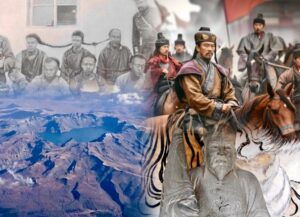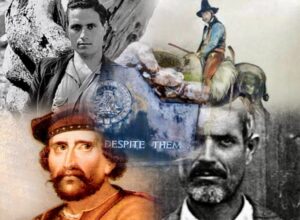The value of individualist pioneers
Early explorers often hired local guides to show them around. Most new climbers and adventurers today hook up with a veteran to learn the ropes.
But what happens when people climb only in guided tours; some even roaming the globe with a private entourage of sherpa?
Do they actually learn skills and survival at all?
In relation to deaths on Everest last spring, Aussie veteran mountaineer Andrew Lock questioned whether the victims were highly experienced climbers, or highly experienced clients:
“And that is a very big difference,” Lock wrote in response to media inquiries, “because irrespective of how many times they’ve been guided on other mountains, clients depend on others for appropriate leadership, risk management and care.”
In media, shepherded endeavors “for a cause” are overtaking riders exploring for the spirit alone. How will these examples inspire human progress?
In his meticulously researched book, From Vinland to Mars, a journalist close to the Apollo missions wrote about the change from self sufficient astronauts to people flying as payloads in the second half of 1969, and the effect it had on space exploration at large.
Shipton and Tilman Spacemen
Few people today realize how gung-ho pioneer cosmonauts and astronauts once were, much more like Tilman and Shipton than the national and commercial sieges later replacing the alpine style.
When Gagarin first stepped into his space capsule he was surrounded only by a small flock of technicians. “It’s not safe yet,” one urged him, “don’t go!”
But Gagarin called his own shots and the rest is history.
The Russian and his mostly unknown counterparts, in US as well as in USSR, would actively watch and participate in each other’s launches till they knew every step by heart.
There were few protocols. Exploration meant touching the edge, and see how it goes. EVAs took place by the pilots cautiously opening a hatch and sliding out. The first space station experiment consisted two capsules hooked to each other by a simple nylon rope.
The men would adjust trajectories in space by moving around their body weight and parachute back to earth landing on their feet right next to startled peasants toiling in the fields.
They all went higher and higher, until… something happened. The next generation astronauts became payload, the equivalent of today’s guided mountaineers.
Space puppets
From Vinland to Mars takes the reader through a thousand years of human desire for New Worlds.
Kicking off with America being discovered by a Viking in a dispute over a bed frame; the author – veteran space journalist Richard S. Lewis – lands at rovers sailing to the stars. It’s a fascinating journey, chockfull of history lessons to guide our future.
Here’s what the eye-witness chronicler wrote about the change from self sufficient astronauts to people flying as payloads in the second half of 1969:
“The whole pattern of exploration changed. The image of the explorer as solitary hero pitting brain and brawn against the elements to challenge nature faded away and was replaced by federal bureaucracy that managed a team. The men who landed on the moon and later explored it were the players. The team, in turn, formed the apex of a social pyramid comprising the scientific, technical, and industrial power of a whole society.
Exploration of the moon was no longer an example of individual derring-do, but of national prowess. The explorer himself was largely controlled, puppetlike, by an electronic string that tied him to Mission Control.”
The next frontier – Himex style
People who watched the Everest reality show on Discovery Channel know commercial leader Russell Brice (Himex) follows climbers in binoculars; deciding from base camp who is fit to continue the climb, and who is not.
Similarly Lewis, now passed, describes how Space flight became an exercise in military style discipline, social coordination and industrial organization:
“[…] On the Moon, the astronauts followed a flight plan so detailed that any deviation from it required a justification to Mission Control at Houston. Each lunar mission was rehearsed in more detail than a stage play, with even less leeway for extemporaneous performance.
“[…] Under these circumstances, the men on the Moon became consenting marionettes, subordinating their own will and often their judgement to the wisdom and and judgment of the flight plan, or, in an emergency, to the decision of the group back at Mission Control. There were no Amundsens nor Scotts in space. The explorer was, in reality, the bureaucracy, and the astronaut was its representative.
“[…] The submergence of individual roles and judgments to those of the leadership and the bureaucracy it served was the main reason that several scientist-astronauts quit the program even before it became apparent they would never have a chance to fly.”
Something amiss
With the fast advances to increasingly higher altitudes, Lewis reports how the space missions soon swelled to hundreds of thousands of ‘outfitters’: employees, engineers, scientists and Universities.
Yet although we “topped out” at the Moon, something went missing in the process.
Scientific objectives replaced adventure spirit which flamed out, taking with it public interest.
Lewis recounts NASA’s subsequent struggle,
“Yet, although the heroic age of exploration had ended […], the public affairs component of NASA made a conspicuous effort to revive it in the personna of the astronauts. Their flight successes were treated as individual achievements and triumphs.
They were idolized, heroized, and exhibited around the world in a manner that would have done justice to Columbus, Magellan, Drake or Cook. But as each of them invariably confessed, they were merely the apex of a social and technical pyramid, the extension of an industrial organism.”
The lesson – and our future
Why the intense NASA effort to mimic original individualism of pioneers? The collective human soul seemed to crave it, and when it wasn’t getting it the future of Space exploration was jeopardized.
Following the Moon landings NASA wanted to send men to Mars. The tech was almost there but the agency needed the president to bankroll the project. Voters, “the beer and pretzel audience” once so easily enamored with exploration heroes, failed to show up.
Concludes the From Vinland to Mars author:
“The post-Apollo space program occupied Nixon’s attention only intermittently in the latter half of 1969 and early 1970. As time passed and domestic problems intensified, Nixon’s enthusiasm for space exploration, which had peaked during Apollo XI, began to wane, along with that of the public.”
Shipton never got to climb Everest, although he scouted the route a large British effort finally conquered by the means of a well-selected figurehead. After the climb, Edmund Hillary never returned to another 8000er and after the Moon we never went on to Mars.
Man began a descent back to Earth orbit and lately we can’t even leave our planet without the Russians.
There is a silver lining to this tale. Exploration history, meticulously documented by contemporaries such as Richard S. Lewis, shows we don’t need cicerones and big outfits to get back out there.
All it takes are individuals with huge drives and self-confidence.
Or just an angry Viking and a fancy bed frame.
Related stories:
Exweb interview, Andrew Lock: “I just haven’t sought the limelight”
ExWeb interview: Andrew Lock, the final 8000ers In Obscurity
Previous by Tina:
“Flight of the Century”: Chat with Broad Peak Birdman Antoine Girard
Climbers banned? Sherpa outlawed? Nanga safe? Pythom Q&A with ACP
Interview: Amazon legend Desert bound
Editorial: The Guinness Book of Crap Records
Tina’s Lab:
Success: Jupiter’s first date with Juno
Space: Dispatches from the Garden of the Gods, 5-part series






